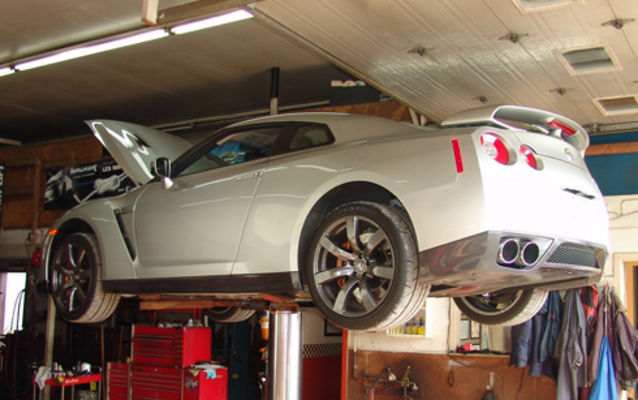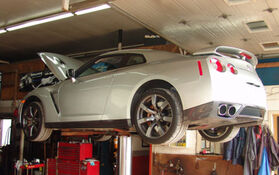At the garage with the Nissan GT-R!
Much has been written about the Nissan GT-R, to say the least. While testing the sports car over a few days last summer, we brought it to Garage Roch Lavallée et Fils in Granby for a more thorough inspection. The findings were interesting and sometimes surprising…
Under the hood
Right away we notice several radiators under the hood and there is an intercooler for each of the twin turbochargers. At the front of the engine, there are two round covers that hide the components of the variable valve timing. The oil used is synthetic (Mobil 1 0W-40 is recommended). The battery and the brake fluid reservoir are insulated. The suspension is attached to the frame that surrounds the engine, which is made of an extremely rigid composite that is without a doubt lighter than steel but its primary benefit is that it shatters on impact, thus preventing damage elsewhere on the chassis and other areas.
Air!
The GT-R’s front end is designed to take in a lot of air but there are very few air outlets, which are essential for maintaining ideal engine bay temperature. However, we did not have a single problem with engine heat, even during testing in Arizona last spring.
Too much insulation?
Seen from underneath with the GT-R up on the hoist, the bottom is strikingly flat. A good deal of the back end is covered with a carbon-composite plate, while the front end is hidden by a hard plastic plate. The space between the two makes for easy access during oil changes, but for any other job, it will have to be removed. Between these two plates, under the passenger compartment, there is a healthy layer of insulation, and all of the gaskets are just as well-insulated.
Single or dual exhaust?
The exhaust system is surprising. While we expected it to be a dual exhaust from one end to the other, it becomes a single exhaust at the catalytic converter and turns into a dual exhaust again just before the exhaust outlets, which again, are smaller than the finishers would lead you to believe.
Suspension designed for the track
The suspensions are also surprising. The parts located at the front are fairly typical for this type of vehicle but, at the back, the braces are very small. They are embossed at strategic points to fold more easily in the event of impact, thus minimizing significant damage to the chassis. We quickly came to the conclusion that the GT-R is made to burn rubber on a race track rather than on our dilapidated old roads.
Two driveshafts
It is also noteworthy that there are two driveshafts. The GT-R engine is located at the front, while the transmission is located at the rear for better weight distribution, so one driveshaft is needed from the transmission leading to the rear wheels and another running from the transmission is needed to activate the front wheels. The one that runs from the front to the back is made of carbonfibre while the other one is metal.
The Nissan GT-R is excellent from a technical standpoint despite the fact that since its introduction, its image has been tarnished by harsh criticism (speed records on the Nürburgring called into question, extreme reluctance of Nissan Canada to put its GT-R on the track, rough transmission and/or all-wheel drive, etc). Will it age gracefully? The next few years will tell the tale…












